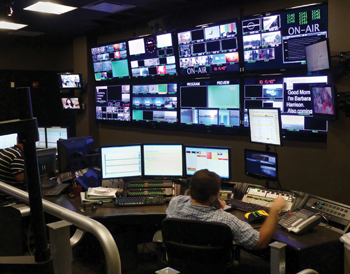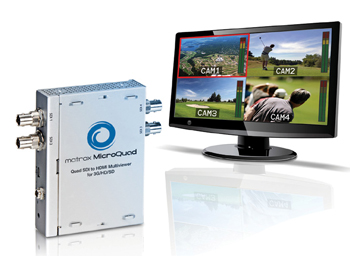Multiviewers Simplify Control Room Monitoring

WRC’s control room has eight monitors with multiviewer displays. The display in the bottom row, second from right, is designated the emergency display in the event of a main multiviewer failure.
ALEXANDRIA, VA.: A multiviewer is a device that puts multiple images on a single display, and it is one of the hottest product categories in the industry today. That’s a little amusing, considering that the exact opposite of multiviewers was the trendy product about 15 years ago.
For a couple of years back then, monitor walls were the trendy high-tech product. These stacked several monitors and spread a single image over all of them—exactly the opposite of what a multiviewer does today.
Monitor wall displays of the kind we saw 15 years ago were never more than a passing fad, but multiviewers are here to stay. Once large and inexpensive flat-screen displays became available, multiviewers permitted much more efficient use of space and money than was available with walls of small CRT monitors.
“With traditional monitors, we wouldn’t have been able to use this room,” said Rob Gibson, manager of technical operations at NBC O&O WRC-TV in Washington, D.C.
Gibson pointed to WRC’s control room wall covered with 55-inch Samsung consumer displays. The flat-screen displays need much less depth than a CRT wall, and a multiviewer system provides other significant advantages.
“This wall makes no noise, makes less heat and it’s very easy to configure,” Gibson said. “If we need to replace one of these [flat-screen displays], it’s a lot easier than replacing a lot of little monitors.”
Get the TV Tech Newsletter
The professional video industry's #1 source for news, trends and product and tech information. Sign up below.
WRC’s control room, where the large displays are, is separate from the equipment room where the actual multiviewer processors are located. That keeps the multiviewer’s fan noise and processor heat out of the control room, making the control rooms a more comfortable and productive space.
WRC uses four Miranda Kaleido multiviewers: two with 96 inputs, one with 48 inputs and one with 16 inputs, which is the emergency system if the main units should fail. In addition to eight large-screen displays in the main control room, there is one large monitor with a multiviewer display in an adjacent audio control room.
SIZE AND POSITION
Almost all multiviewers let you size and position images on the monitor, and then allow you to change and save configurations so that you can customize the look. For example, you can have a display for the 6 o’clock news and another for a weekend sports talk show. Producers and directors can have customized configurations for their preferred viewing, then the next set of producers and directors can adjust the setting for their preference.

The new low-cost MicroQuad multiviewer from Matrox Many other companies make multiviewers in a wide range of sizes and capabilities. For example, the Apantac Tahoma MiniQ can be used as a standalone fourinput unit or up to eight modules can mount in a 3RU chassis. The MiniQ accepts composite, SD, HD and 3G SDI signals with automatic signal detection. It has HDMI/DVI and SDI outputs, and can display embedded audio meters.
“The Tahoma MiniQ is an ideal multiviewer solution for space-restrictive mobile trucks and studio monitoring applications,” said Thomas Tang, Apantac’s president. “Truck multiviewers must be compact, hot-swappable from the front, have low power consumption and run extremely cool.”
Matrox just announced a four-input multiviewer called the MicroQuad, which the company said is the world’s first quad SDI-to-HDMI multiviewer for less than $1,000. With so much diversity among multiviewer products, Charles Amyot, product manager for Matrox video products group, said that there are a few things that every customer should look for in a multiviewer.
“Video quality is the most important consideration when choosing a multiviewer,” Amyot said. “They need artifact-free monitoring so that there are no surprises when switching a source to the on-air feed.”
Avitech, which has placed multiviewers with such high-profile clients as Nintendo and ESPN, has the Sequoia 4H and 2H2U units. The 4H incorporates four HDMI inputs and is targeted at custom A/V installations and meeting rooms, while the 2H2U includes audio metering and is aimed at broadcast. The Sequoia 4H and 2H2U further differentiate themselves from the competition by supporting mouse/keyboard control, audio switching and touchscreen functionality.
ENGINEERING-FRIENDLY
The VIP-M dual-output display processor from Evertz features small size, low cost and high performance. It also has some engineering-friendly features that may make it the right choice for some applications.
“VIP-M’s advanced features include audio loudness measurement, Dolby E monitoring, macro block detection, which is in addition to the standard monitoring features available on all of Evertz’ multiviewer products,” said Jamie Horner, director of system solutions for Evertz.
Wohler’s RMV16-3G-HDMI multiviewer card supports four auto-detecting video inputs that can handle just about any analog or digital format, and it has two HDMI outputs that make it convenient to plug into standard consumer large-screen displays. Up to 16 RMV16-3G-HDMI cards can mount in a Wohler RMV16-16C-3RU chassis for a 64-input system. Each window within a display supports audio de-embedding, metering of up to eight channels, timecode and clock insertion.
Harris has a multiviewer system that builds multidisplay technology into the company’s Platinum routing switcher. The HView SX Hybrid multiviewer is an output module that is added to the 5-, 9-, 15- and 28-RU Platinum router chassis, and can auto-detect HD/SD, analog and digital. The HView SX Hybrid multiviewer has access to the entire signal matrix in the Platinum frame, so that a full 28RU chassis can monitor 512 baseband input signals and drive 64 independent HD-SDI monitors.
One of the most interesting things about multiviewers is that they are invariably used with reasonably priced consumer- grade large-screen displays. Years ago, monitor walls were built up from professional-grade monitors, each costing anywhere from $500 to $2,500, and there might be 20 or 30 of these monitors in a decent-sized control room. To save money, many source monitors would be black & white, while the more important monitors would be color.
Today, a large control room has eight large-screen consumer displays that show 80 or more discrete video images, all of them in color that is surprisingly uniform. These displays consume far less power, generate less heat and require much less cabling than discrete monitors, and these modern configurations can be changed at the click of a button on a computer screen.
Multiviewers have become the preferred monitoring solution to the point where they are now considered a necessity— to the point where some production switchers have multiviewer capability built in. It won’t be long before we will say, “How did we do this before multiviewers?”
Bob Kovacs is a television engineer and video producer/director. He can be reached atbob@bobkovacs.com.
Bob Kovacs is the former Technology Editor for TV Tech and editor of Government Video. He is a long-time video engineer and writer, who now works as a video producer for a government agency. In 2020, Kovacs won several awards as the editor and co-producer of the short film "Rendezvous."

